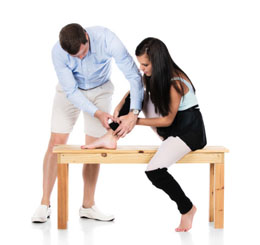The root cause of a bruised heel is forceful hitting of the area against a hard surface. Most significant symptoms of heel bone bruise are pain, soreness, and inflammation in the affected part. Read this Buzzle article to find out causes, symptoms, and treatment of a bruised heel bone.

The heel bone, also known as calcaneus and os tarsi fibulare, represents the largest structure of all the foot bones. Despite its size and strength, it is prone to bruising and fractures. With repeated use, the fat pad (corpus adiposum) that cushions this bone gets displaced, thereby exposing it to painful injuries. In fact, mildly bruised calcaneus in children and adults is a commonly reported case. Active children and athletes, especially those who indulge in jumping activities, weightlifting, racket sports, and gymnastics are more likely to notice bruised heel bone symptoms than others.
What Causes Bruising of the Heel Bone?
Bruising and pain are not surprising for the heel, as the sole of the foot bears the whole body weight, and is subjected to pressure during standing, walking, and running. Heel bruise or periostitis (inflammation of the periosteum, a layer of connective tissue that surrounds the bone) is significant, when an individual jumps and hits the ground on his/her feet with a strong force. The same thing happens while falling from heights, and in some cases of motor accidents. In such situations, the calcaneus and the surrounding bones absorb the shock of landing on the hard surface. Heel contusion often leads to swelling in the affected area.
Signs and Symptoms
As with any kind of bone bruise or contusion, a bruised heel results in extreme pain. Heel pain may be caused due to various conditions, for example, sprained heel. So, identify a bruised bone by holding the affected area gently, and pressing it lightly at the center with the thumb. If a sharp, excruciating pain is felt with increased pressure, then most likely it is a bruised bone problem. Pain is due to the forceful impact of the feet with a hard surface, which in turn causes minor fractures to the heel bone.
The pain intensity depends on the causes of bruised calcaneus. Besides falling from heights and jumping, bruised heel may be associated with underlying conditions like bursitis, plantar fasciitis, heel spur, tarsal tunnel syndrome, stress fracture, and other heel bone deformities. In most of the cases, the associated symptoms of a bruise on the heel of a foot are soreness and inflammation. The person may not be able to move the foot. Being overweight and wearing ill-fitting footwear can contribute to bruised bone symptoms.
In general, bruising of the heel bone is not a serious case. The fractures caused by a trauma are usually so minor that they remain undetected during an X-ray imaging test. On the brighter side, this orthopedic condition can be treated at home with simple remedies. The sooner it is treated and taken care of, the shorter will be the recovery time. Otherwise, severe inflammation of the bruised heel pad is obvious, which takes longer time to heal.
How to Heal a Bruised Heel
Bruised heel treatment involves complete resting of the affected area. This is to encourage natural healing process of the calcaneus, and promote quick recovery. Further pressurizing the heel exacerbates inflammation, and lengthens the healing period. Using a support system during standing and walking is a conventional way to reduce pressure over the afflicted heel bone. Applying ice over the painful heel, and compression therapy of the soft tissues in the area will give pain relief to some extent.
Wearing loose and comfortable footwear is suggested for managing heel pain. Sports shoes with even cushioning for the sole are better alternatives to other footwear options. If the pain still persists, using heel pads or shoe insert is suggested. These are worn along with shoes for shock absorption, as they support the calcaneus and other tarsal bones of the foot. In addition, they give a protective effect to the fatty pads too. With proper care, the bruised heel bone symptoms will subside gradually.
Complete bruised heel recovery is usually achieved within 1-1½ months. Some patients may recover in just 4 weeks, while some may take as long as 3 months to recover. In case of persisting heel pain, one should consult an orthopedist. The health specialist may administer injections to soothe pain. If required, electrotherapy sessions will be arranged.
Disclaimer: The information provided in this article is solely for educating the reader. It is not intended to be a substitute for the advice of a medical expert.


 The heel bone, also known as calcaneus and os tarsi fibulare, represents the largest structure of all the foot bones. Despite its size and strength, it is prone to bruising and fractures. With repeated use, the fat pad (corpus adiposum) that cushions this bone gets displaced, thereby exposing it to painful injuries. In fact, mildly bruised calcaneus in children and adults is a commonly reported case. Active children and athletes, especially those who indulge in jumping activities, weightlifting, racket sports, and gymnastics are more likely to notice bruised heel bone symptoms than others.
The heel bone, also known as calcaneus and os tarsi fibulare, represents the largest structure of all the foot bones. Despite its size and strength, it is prone to bruising and fractures. With repeated use, the fat pad (corpus adiposum) that cushions this bone gets displaced, thereby exposing it to painful injuries. In fact, mildly bruised calcaneus in children and adults is a commonly reported case. Active children and athletes, especially those who indulge in jumping activities, weightlifting, racket sports, and gymnastics are more likely to notice bruised heel bone symptoms than others.